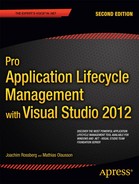PART 3
![]()
Analysis, Modeling, and Design (Architecture)
Part III covers how we can plan for the development of our application or system using many of the tools in Visual Studio 2012. We begin by looking at how to use the PowerPoint add-ons that Visual Studio offers to create a storyboard. Storyboarding visualizes (or models) the flow of our application and can be a great way to sit down with a non-technical stakeholder and gather requirements and information. Storyboards are also great as a foundation for design discussions during sprint planning if you are using Scrum.
The Unified Modeling Language (UML) is a modeling method many people are used to. Visual Studio 2012 has UML support included and can be used in various stages of both planning and development. We see some basic UML modeling and how we can use Visual Studio to create these models.
Many developers find themselves with old code that they need to maintain. Poor documentation can make this task hard. Using the Architecture Explorer we can visualize existing code as well as new code, making it more readable and understandable.
Layer diagrams are part of the architecture tools in Visual Studio Ultimate and they are used to model the layers in a solution. Once the layers are defined we can define the dependency structure between the layers and map code to the corresponding layer. With this information in place, the model can be used not only as documentation but also to enforce that modules in the application do not take dependencies outside what is defined in the model.
